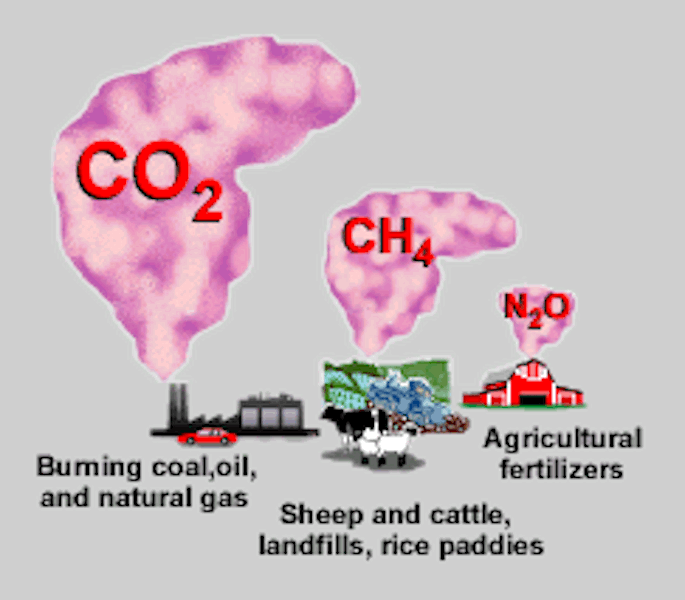The Three Main GHGs

The three main greenhouse gases (GHGs) — carbon dioxide, methane and nitrous oxide — are all long lasting in the atmosphere and, because of their sources, they are constantly being emitted. It follows that to stop global warming, it is necessary to virtually stop our industrial age emissions of these three greenhouse gases especially.
The greenhouse gas that everyone knows about is CARBON DIOXIDE or CO2. What we forget about CO2 is that over 30 percent of industrial carbon dioxide emissions are absorbed by the oceans, which have undergone rapid acidification as a result. Carbon dioxide is non-reactive in the atmosphere and about 20 percent of CO2 emissions will last in the atmosphere, radiating heat, for 1000 years. Global warming therefore cannot be stopped without stopping the emission of carbon dioxide — what we call "zero carbon emissions."
METHANE (CH4) is chemically reactive in the atmosphere and lasts only about 12 years, but over this period of time its heating capacity is approximately 100 times that of carbon dioxide. (The IPCC figure is 72 times the heat-forcing effect of carbon dioxide over 20 years.)
To add to the importance of methane, the global warming caused by methane emissions does not stop at 12 years because it is oxidized to other greenhouse gases: water vapour, ozone and, notably, carbon dioxide. In order of importance, the sources of methane emissions are wetlands, fossil fuels, landfills, ruminant animals, rice paddies and biomass combustion. Therefore industrial and agricultural emissions of methane have to be controlled in order to stop global warming.
NITROUS OXIDE (N2O) lasts in the atmosphere for over 100 years, and is approximately 300 times more potent a greenhouse gas than CO2. Atmospheric levels of nitrous oxide have risen by more than 15% since 1750, and about a third of current N2O emissions are anthropogenic, stemming from synthetic nitrogen fertilizers, the chemical industry, the manure of cattle feedlots, fossil fuel burning, and fugitive emissions from the natural gas industry. Nitrous oxide also causes ozone depletion and is now considered the single most important ozone-depleting substance.
Generally speaking, and to make things simple, there are two broad sectoral origins of greenhouse gas emissions, both of which emit the three main greenhouse gases.

- Fossil fuel energy production and use
- Food production (I.e. human energy production)
Fossil Fuel Energy Production and Use
The sector that immediately comes to mind is the production of energy by fossil fuel combustion. This, of course, involves heating and air conditioning for homes and buildings, energy for the various forms of transportation, and energy for industry and manufacturing. Fossil fuels (coal, oil and natural gas) emit carbon dioxide and to some extent methane and nitrous oxide in their production and combustion.
Food Production
The other sector in this broad division, which receives little attention, is industrial food production. After fossil fuel combustion, another significant source of carbon dioxide emissions is deforestation: the cutting down of trees. Most of the deforestation results from clearing forests for livestock pasture.
The industrial food production system is also a major direct cause of carbon dioxide emissions from, for example, transportation, the slaughter industry, refrigeration. A big source of methane is the gut of ruminant (an even-toed ungulate mammal) such as cattle livestock and large-scale farming for beef production. Animal manure emits ammonia, which is converted in the air to the greenhouse gas nitrous oxide. Furthermore, industrial chemical-intensive agriculture relies on nitrogen fertilizers, which are a big source of nitrous oxide.

Copyright © All Rights Reserved

